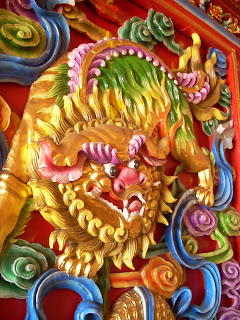More eating of things with and without faces! Drunken shrimp(s)!
Bamboo! This stuff is tasty! People at work have been asking me about things we ate in Taiwan, and the one I'm always talking about is this. Because it's so tasty! It's like baby bamboo shoots all steamed up. The white dipping sauce is actually like a sweet mayonnaise. These particular ones, you peel back the outer leave and dip them in the sauce. At another restaurant they had been pre-cubed, the mayo drizzled over them, and then decorated with rainbow sprinkles!
Noodles!
After we ate all these things and much much more, we headed to the Paper Church/Dome. The brochure says, "Paper Dome," while Liang's Dad kept calling it "Paper Church." Built, as you may suppose, of paper, it is located in a pretty spot not too far from Sun Moon Lake.
The Paper Church.
This was originally built in Japan as a temporary structure, after a terrible earthquake destroyed a community church. Years later, after the Japanese city had rebuilt, a very strong earthquake hit Taiwan (not too long ago, as Liang was in high school? yes?). Massive destruction ensued. The Japanese city and the members of the Paper Church felt such sympathy, remembering their own devastating earthquake experience, that they decided to pack up their no-longer-needed paper church and send it to Taiwan. The Paper Church was then relocated to its present location, a few miles from the earthquake epicenter.
The English brochure reads like some sort of free-verse poem:
Paper Dome,
A distinctive architecture made of paper pillars,
Associated the Great Hanshin earthquake in Japan with the
921 Earthquake in Taiwan. It accompanied residents in Kobe
to recover from the trauma.
Paper Dome, now traveling a long way from across the ocean
Will bring new spirit to Taiwanese communities
With her new-born charisma.
Earthquake, though, shows us the cruelty of devastating power, it discloses the perseverance of the recovery as well as love and mutual assistance among people.

























































